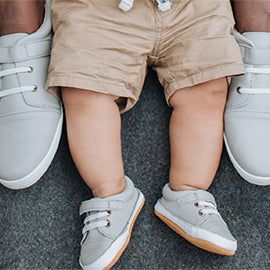As pelvic floor physical therapists, we help women prepare for labor and educate women on the role of the pelvic floor during labor. The main role of the pelvic floor during labor is to dynamically relax and lengthen to facilitate the passage of the baby through the birth canal. It is not about how strong your pelvic floor is or how powerfully you can push a baby out. It is more important to understand how to coordinate breath with contractions and strategically adjusting positions during labor to help optimize the pelvic floor's position. By actively engaging in these practices, mamas can enhance the adaptability and flexibility of the pelvic floor muscles, creating an environment that supports a smoother birthing process. This proactive approach contributes to setting the stage for a more controlled and potentially less challenging birth experience, fostering a sense of empowerment as you prepare for the big day!
Are you ready for it?
Here are five of our top birth prep tips!
Breathing and Relaxation

As we mentioned above, the main job of the pelvic floor is to lengthen during delivery. One way you can start to prepare your body to relax and lengthen during delivery is to connect with your pelvic floor now. One way to get that connection is through 360 breathwork! No matter what phase of pregnancy you are in, this is a useful tool for you to use.
So what is 360 breathing?
As pelvic floor PTs we recommend utilizing 360 breathing as opposed to belly or chest breathing. 360 breathing is when you take a long slow inhale trying to equally fill your rib cage, abdomen and pelvic floor in all directions. Your ribs should expand laterally as well as to the front and back. Your low back should expand as your belly expands and your pelvic floor should descend on your inhale. The opposite happens on an exhale. This can be practiced in any position: lying on your back, side, sitting, standing, in a deep squat and even on the toilet.
Once you have mastered 360 breathing, let's put it into practice to help you prepare for birth. Let’s practice trying to breathe your poop out! Yep, working to learn how to breathe your poop out as opposed to pushing your poop out mimics the mechanics of delivering a baby. So, if you can successfully breath your poop out you could be helping to set yourself up for a smoother delivery. Muscle memory is a thing, so even if you have an epidural, working to master breathing your pop out can help your body remember what to do when you are in the heat of the moment.
To learn more about 360 breathing and to see video tutorials on how to properly complete 360 breathing head to our blog.
Stretching
As the big day draws near, it's time to get your body groovin' and stretchin'. Picture it as a little pre-game warm-up to ensure your body is all set for delivery. Remember what we mentioned earlier, your pelvic floor needs to be able to relax and lengthen. By working to get comfortable with hip and pelvic floor mobility prior to delivery, you can help train your body for labor.
The optimal stretch that could work wonders for you are like a custom mixtape, prescribed by a pelvic floor PT. They target your specific tight spots, making sure you're limber and ready for the big moment.
With that, 3 stretches that could work wonders for you if you are pain free and feeling up to it are:


 Master the stretches with these videos!
Master the stretches with these videos!
Perineal Massage
If you're a 3rd trimester mama, you have likely heard the buzz about perineal massage? We like to think of it as a way to better understand and embrace your body as you prepare for delivery. Now, the research might be playing hide-and-seek on whether it prevents tearing, but guess what? We say, why not give it a shot in the last 6 weeks leading up to your big day!
Why, you ask? The more you familiarize yourself with your body, the more confident you are in how your tissues stretch and move. The more your brain connects to this unseen area, the more comfortable you'll be during delivery and the more prepared your body will be to stretch and lengthen.
We get it – pain and the unknown can be nerve-wracking, but here's the secret sauce: perineal massage helps you prep, touch, and get comfy with what's to come. Think of it as a friendly hello to your vulva before the big day!
Curious about the how-to? Dive into the deets on our blog detailing what perineal massage is and how to complete it.
Strengthening Exercises
When preparing for delivery, it is also very important to try and strengthen your core, pelvic floor and glutes. Yes we need length and relaxation but this is a marathon, not a sprint, and the stronger you are the better you will be able to not only handle delivery but also recover from it.
If your pregnancy allows, we recommend targeted strength training throughout every stage of pregnancy. As your belly grows, modifications are required to ensure proper pressure management strategies but ideally you can continue to strengthen up until your delivery date.
We do recommend you seek professional advice if you have any pain or discomfort but if you are having a pain free, uncomplicated pregnancy give these exercises a try to help prepare your body for delivery.



Explore this video guide for a step-by-step walkthrough of the exercises. These should be pain free and help to make your body feel better when you finish, NOT worse!
Pelvic Positions for Each Stage of Labor
As the anticipated day approaches, preparing your body for the various stages of labor can be both a comforting and educational practice. It's beneficial to engage in exercises that encourage optimal positioning for your baby throughout labor's progression. Learning not only what these are but also practicing them prior to delivery can help you prepare your body for the 3 stages of labor.
In the initial phase of labor when you are between 0-6 centimeters of dilation, deep squatting is helpful as it aids in opening the top of the pelvis, facilitating an easier descent for your baby. Visualizing and practicing this position before delivery can help your body prepare for the movement and tolerate the position better. While you are in labor, try and utilize this position during an active contraction if possible, if not moving in and out of this position can contribute to a smoother early stage of labor.

As dilation progresses to 6-9 centimeters, focus shifts to emphasizing pelvic rotation. What does that mean? Instead of your hips moving forward and back we need rotational movement to help baby's head navigate the birth canal.

Transitioning into active labor, the objective is to open the bottom of the pelvis, where positioning your knees in and heels out becomes instrumental. This posture encourages the separation of your sits bones, creating additional space for the birthing process.

Incorporating these visualizations and movements into your preparation can enhance your understanding of the birthing journey, promoting both physical readiness and a sense of empowerment.
Watch a video demonstration of the above pelvic positions.
Whew, that was a lot! At Empower Physical Therapy and Wellness, we understand that motherhood is tough on both your brain and your body! We're a women-only pelvic health practice dedicated to supporting mamas throughout pregnancy and postpartum. Forget struggling alone or accepting "normal" issues - we empower you to feel strong, confident, and ready to tackle motherhood head-on, doing all the things you love. Let's ditch the dysfunction and find joy in movement again!
If you have any additional questions please feel free to reach out to us through our website at Empower Physical Therapy and Wellness.
Contact Information
Email: Hello@weempowerpt.com
Phone/text: 678-413-5587
























